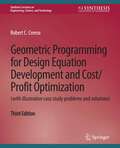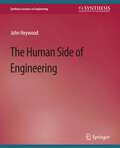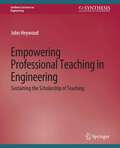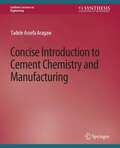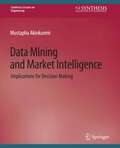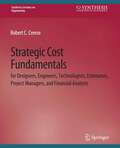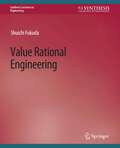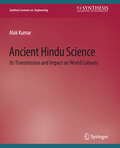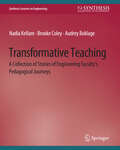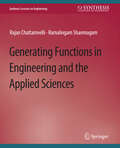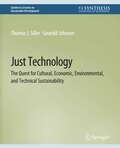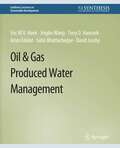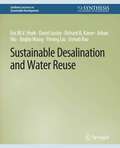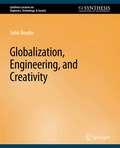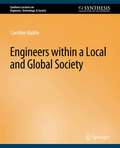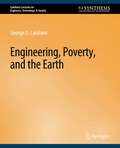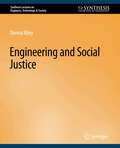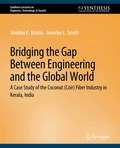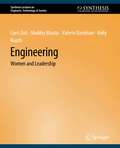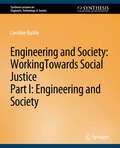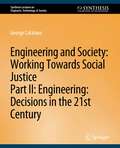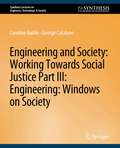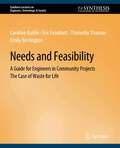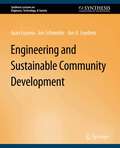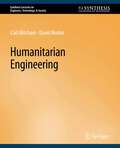- Table View
- List View
Geometric Programming for Design Equation Development and Cost/Profit Optimization (Synthesis Lectures on Engineering)
by Robert CreeseGeometric Programming is used for cost minimization, profit maximization, obtaining cost ratios, and the development of generalized design equations for the primal variables. The early pioneers of geometric programming—Zener, Duffin, Peterson, Beightler, Wilde, and Phillips—played important roles in its development. Five new case studies have been added to the third edition. There are five major sections: (1) Introduction, History and Theoretical Fundamentals; (2) Cost Minimization Applications with Zero Degrees of Difficulty; (3) Profit Maximization Applications with Zero Degrees of Difficulty; (4) Applications with Positive Degrees of Difficulty; and (5) Summary, Future Directions, and Geometric Programming Theses & Dissertations Titles. The various solution techniques presented are the constrained derivative approach, condensation of terms approach, dimensional analysis approach, and transformed dual approach. A primary goal of this work is to have readers develop more case studies and new solution techniques to further the application of geometric programming.
The Human Side of Engineering (Synthesis Lectures on Engineering)
by John HeywoodWhile in many university courses attention is given to the human side, as opposed to the technical side of engineering, it is by and large an afterthought. Engineering is, however, a technical, social, and personal activity. Several studies show that engineering is a community activity of professionals in which communication is central to the engineering task. Increasingly, technology impacts everyone in society. Acting as a professional community, engineers have an awesome power to influence society but they can only act for the common good if they understand the nature of our society. To achieve such understanding they have to understand themselves. This book is about understanding ourselves in order to understand others, and understanding others in order to understand ourselves in the context of engineering and the society it serves. To achieve this understanding this book takes the reader on 12 intellectual journeys that frame the big questions confronting the engineering professions.
Empowering Professional Teaching in Engineering: Sustaining the Scholarship of Teaching (Synthesis Lectures on Engineering)
by John HeywoodEach one of us has views about education, how discipline should function, how individuals learn, how they should be motivated, what intelligence is, and the structures (content and subjects) of the curriculum. Perhaps the most important beliefs that (beginning) teachers bring with them are their notions about what constitutes "good teaching". The scholarship of teaching requires that (beginning) teachers should examine (evaluate) these views in the light of knowledge currently available about the curriculum and instruction, and decide their future actions on the basis of that analysis. Such evaluations are best undertaken when classrooms are treated as laboratories of inquiry (research) where teachers establish what works best for them. Two instructor centred and two learner centred philosophies of knowledge, curriculum and instruction are used to discern the fundamental (basic) questions that engineering educators should answer in respect of their own beliefs and practice. They point to a series of classroom activities that will enable them to challenge their own beliefs, and at the same time affirm, develop, or change their philosophies of knowledge, curriculum and instruction.
Concise Introduction to Cement Chemistry and Manufacturing (Synthesis Lectures on Engineering)
by Tadele AragawThis book is designed to be used in an introductory sophomore-level undergraduate course in chemical engineering, civil engineering, industrial engineering, chemistry, and/or industrial chemistry. Senior-level students in resource development, soil science, and geology might also find this book useful. In addition, it is our hope that even advanced mathematics-oriented high school seniors might find the material easy to master as well. This book emphasizes concepts, definitions, chemical equations, and descriptions with which some chemical science professionals struggle. It stresses the importance of maintaining uniformly high standards in pure chemical science and manufacturing technology while still keeping in mind that procedures that might seem strange also yield results that prove effective.
Data Mining and Market Intelligence: Implications for Decision Making (Synthesis Lectures on Engineering)
by Mustapha AkinkunmiThis book is written to address the issues relating to data gathering, data warehousing, and data analysis, all of which are useful when working with large amounts of data. Using practical examples of market intelligence, this book is designed to inspire and inform readers on how to conduct market intelligence by leveraging data and technology, supporting smart decision making. The book explains some suitable methodologies for data analysis that are based on robust statistical methods. For illustrative purposes, the author uses real-life data for all the examples in this book. In addition, the book discusses the concepts, techniques, and applications of digital media and mobile data mining. Hence, this book is a guide tool for policy makers, academics, and practitioners whose areas of interest are statistical inference, applied statistics, applied mathematics, business mathematics, quantitative techniques, and economic and social statistics.
Strategic Cost Fundamentals: for Designers, Engineers, Technologists, Estimators, Project Managers, and Financial Analysts (Synthesis Lectures on Engineering)
by Robert CreeseThis book is designed to introduce designers, engineers, technologists, estimators, project managers, and financial analysts as well as students in engineering and business to strategic cost tools for project cost evaluations. The three main sections are as follows. (1) Cost Relationships, Financial Statements, and Performance Measures—This section describes the relationships between cash flows and profits; the relationships between financial statements and the Purcell Diagram; and the issues of cost estimating, time-based breakeven analysis and time-based earned schedule. (2) Tools for Economic Evaluations—This section considers the basic mathematical relations used behind the economic equations and factors; discrete and continuous interest; depreciation terms and methods; and the Present Value of Principal Approach for evaluating loans. (3) Methods for Project Evaluation and Risk Analysis—This section considers payback periods, present worth analysis, return on investment, internal rate of return, benefit/cost ratios and positive-negative project balances; risk techniques of sensitivity analysis, optimistic-pessimistic analysis, discrete probability examples, and continuous probability models using the normal and triangular distributions.
Value Rational Engineering (Synthesis Lectures on Engineering)
by Shuichi FukudaEarly in the 20th century, our world was small and closed with boundaries. And, there were no appreciable changes. Therefore, we could foresee the future. These days, however, we could apply mathematical rationality and solve problems without any difficulty. As our world began to expand rapidly and boundaries disappeared, the problem of bounded rationality emerged. Engineeres put forth tremendous effort to overcome this difficulty and succeeded in expanding the bounds of mathematical rationality, thereby establishing the ""Controllable World."" However, our world continues to expand. Therefore such an approach can no longer be applied. We have no other choice than ""satisficing"" (Herbert A. Simon's word, Satisfy + Suffice). This expanding open world brought us frequent and extensive changes which are unpredictable and diversification and personalization of customer expectations. To cope with these situations, we need diverse knowledge and experience. Thus, to satisfy our customers, we need teamwork. These changes of environments and situations transformed the meaning of value. It used to mean excellent functions and exact reproducibility. Now, it means how good and flexible we can be to adapt to the situations. Thus, adaptability is the value today. Although these changes were big, and we needed to re-define value, a greater shift in engineering is now emerging. The Internet of Things (IoT) brought us the ""Connected Society,"" where things are connected. Things include not only products, but also humans. As changes are so frequent and extensive, only users know what is happening right now. Thus, the user in this Connected Society needs to be a playing manager—he or she should manage to control the product-human team on the pitch. Moreover, this Connected Society will bring us another big shift in engineering. Engineering in this framework will become Social Networking, with engineering no longer developing individual products and managing team products. The Internet works two ways between the sender and the receiver. Our engineering has ever been only one way. Thus, how we establish a social networking framework for engineering is a big challenge facing us today. This will change our engineering. Engineers are expected to develop not only products, but also such dream society. This book discusses these issues and points out that New Horizons are emerging before us. It is hoped that this book helps readers explore and establish their own New Worlds.
Ancient Hindu Science: Its Transmission and Impact on World Cultures (Synthesis Lectures on Engineering)
by Alok KumarTo understand modern science as a coherent story, it is essential to recognize the accomplishments of the ancient Hindus. They invented our base-ten number system and zero that are now used globally, carefully mapped the sky and assigned motion to the Earth in their astronomy, developed a sophisticated system of medicine with its mind-body approach known as Ayurveda, mastered metallurgical methods of extraction and purification of metals, including the so-called Damascus blade and the Iron Pillar of New Delhi, and developed the science of self-improvement that is popularly known as yoga. Their scientific contributions made impact on noted scholars globally: Aristotle, Megasthenes, and Apollonius of Tyana among the Greeks; Al-Biruni, Al-Khwarizmi, Ibn Labban, and Al-Uqlidisi, Al-Ja?iz among the Islamic scholars; Fa-Hien, Hiuen Tsang, and I-tsing among the Chinese; and Leonardo Fibbonacci, Pope Sylvester II, Roger Bacon, Voltaire and Copernicus from Europe. In the modern era, thinkers and scientists as diverse as Ralph Waldo Emerson, Johann Wolfgang von Goethe, Johann Gottfried Herder, Carl Jung, Max Müller, Robert Oppenheimer, Erwin Schrödinger, Arthur Schopenhauer, and Henry David Thoreau have acknowledged their debt to ancient Hindu achievements in science, technology, and philosophy. The American Association for the Advancement of Science (AAAS), one of the largest scientific organizations in the world, in 2000, published a timeline of 100 most important scientific finding in history to celebrate the new millennium. There were only two mentions from the non-Western world: (1) invention of zero and (2) the Hindu and Mayan skywatchers astronomical observations for agricultural and religious purposes. Both findings involved the works of the ancient Hindus. The Ancient Hindu Science is well documented with remarkable objectivity, proper citations, and a substantial bibliography. It highlights the achievements of this remarkable civilization through painstaking research of historical and scientific sources. The style of writing is lucid and elegant, making the book easy to read. This book is the perfect text for all students and others interested in the developments of science throughout history and among the ancient Hindus, in particular.
Transformative Teaching: A Collection of Stories of Engineering Faculty's Pedagogical Journeys (Synthesis Lectures on Engineering)
by Nadia Kellam Brooke Coley Audrey BoklageThe journey to becoming an exemplary engineering educator is one that is rarely simple and straightforward. Simply being exposed to active learning strategies or innovative pedagogies rarely leads to a transformation of one's own teaching. In this book, we present a collection of stories from exemplary engineering educators that are told in their own voices. These stories are shared to enable readers to immerse themselves in first-person recollections of transformation, involving engineering educators who changed their teaching strategies from the ways that they were taught as engineering undergraduate students to ways that more effectively fostered a conducive learning atmosphere for all students. It is our hope that providing stories of successful engineering educators might stimulate thoughtful and productive self-reflection on ways that we can each change our own teaching. These stories are not simple, linear stories of transformation. Instead, they highlight the complexities and nuances inherent to transforming the way that engineering faculty teach. Through our strategy of narrative storytelling, we hope to inspire future and current engineering educators to embark on their own journeys of teaching transformations. We conclude the book with some lessons that we learned during our readings of these stories, and invite readers to extract lessons of their own.
Generating Functions in Engineering and the Applied Sciences (Synthesis Lectures on Engineering, Science, and Technology)
by Rajan Chattamvelli Ramalingam ShanmugamThis is an introductory book on generating functions (GFs) and their applications. It discusses commonly encountered generating functions in engineering and applied sciences, such as ordinary generating functions (OGF), exponential generating functions (EGF), probability generating functions (PGF), etc. Some new GFs like Pochhammer generating functions for both rising and falling factorials are introduced in Chapter 2. Two novel GFs called "mean deviation generating function" (MDGF) and "survival function generating function" (SFGF), are introduced in Chapter 3. The mean deviation of a variety of discrete distributions are derived using the MDGF. The last chapter discusses a large number of applications in various disciplines including algebra, analysis of algorithms, polymer chemistry, combinatorics, graph theory, number theory, reliability, epidemiology, bio-informatics, genetics, management, economics, and statistics. Some background knowledge on GFs is often assumed for courses in analysis of algorithms, advanced data structures, digital signal processing (DSP), graph theory, etc. These are usually provided by either a course on "discrete mathematics" or "introduction to combinatorics." But, GFs are also used in automata theory, bio-informatics, differential equations, DSP, number theory, physical chemistry, reliability engineering, stochastic processes, and so on. Students of these courses may not have exposure to discrete mathematics or combinatorics. This book is written in such a way that even those who do not have prior knowledge can easily follow through the chapters, and apply the lessons learned in their respective disciplines. The purpose is to give a broad exposure to commonly used techniques of combinatorial mathematics, highlighting applications in a variety of disciplines.
Just Technology: The Quest for Cultural, Economic, Environmental, and Technical Sustainability (Synthesis Lectures on Sustainable Development)
by Thomas J. Siller Gearold JohnsonTo address the complexity of today's global challenges requires new ways of thinking. The idea that technology is always the best, maybe only, approach worth taking needs to be reconsidered. Sustainable approaches must also draw from non technological areas. To that end, this book introduces the idea of just technology by rephrasing the idea of just war in order to include concepts of sustainability in future engineering design. The book begins by defining justice and relating these definitions to technology. This is followed by illustrating several notions of sustainability and the awareness that needs to be focused on societal challenges due to the finite resources available in the natural world. Four questions are enumerated to be addressed in order to qualify as a just use of technology: (1) Is the harm being inflicted by the problem on the community, the environment, or humanity, in general lasting, serious, and certain? (2) Have all alternative solutions been investigated first, including non-technology-based solutions? Technology is the last choice, not the first! (3) Do we have confidence in the successful implementation of this technological solution? and (4) Is the potential harm from the technological solution potentially worse than the issue being addressed? Have all unintended consequences been considered that could arise from the technological solution? The book ends with a description for implementing these questions into the traditional engineering design process. Examples are included for reflection and help to understand how the design process proceeds.
Oil & Gas Produced Water Management (Synthesis Lectures on Sustainable Development)
by Eric M.V. Hoek Jingbo Wang Tony D. Hancock Arian Edalat Subir Bhattacharjee David JassbyProduced water contributes to the largest volume waste stream associated with oil and gas (O&G) exploration and production (E&P) operations. It is usually a complex mixture of inorganics and organics that is formed underground and brought to the surface during O&G production. Traditionally, produced water has been considered as a waste to the O&G industry. The conventional management strategies include disposal (typically by injection into depleted wells or permitted disposal wells), recycle (direct reuse within the E&P operation), and reuse (treatment and reuse offsite for food crop irrigation, livestock watering or industrial use). The O&G industry is going through a paradigm shift, where scarcity of water, economics of water management, declining oil costs, and increasing focus on environmental and ecological stewardship are shifting the focus toward integrated water management in E&P operations. Water is no longer a problem to be delegated to a third-party disposal or treatment vendor, but is becoming a cornerstone of O&G production. In this review, we summarize produced water characteristics, regulations and management options, produced water treatment fundamentals, and a detailed discussion of process equipment and advantages/disadvantages of currently available treatment processes. These results in peer-reviewed publications could provide a guide for the selection of appropriate technologies based on the desired application. Major research efforts in the future could focus on the optimization of current technologies and use of combined treatment processes of produced water in order to comply with reuse and discharge limits, under more stringent environmental regulations.
Sustainable Desalination and Water Reuse (Synthesis Lectures on Sustainable Development)
by Eric M.V. Hoek David Jassby Richard B. Kaner Jishan Wu Jingbo Wang Yiming LiuOver the past half century, reverse osmosis (RO) has grown from a nascent niche technology into the most versatile and effective desalination and advanced water treatment technology available. However, there remain certain challenges for improving the cost-effectiveness and sustainability of RO desalination plants in various applications. In low-pressure RO applications, both capital (CAPEX) and operating (OPEX) costs are largely influenced by product water recovery, which is typically limited by mineral scale formation. In seawater applications, recovery tends to be limited by the salinity limits on brine discharge and cost is dominated by energy demand. The combination of water scarcity and sustainability imperatives, in many locations, is driving system designs towards minimal and zero liquid discharge (M/ZLD) for inland brackish water, municipal and industrial wastewaters, and even seawater desalination. Herein, we review the basic principles of RO processes, the state-of-the-art for RO membranes, modules and system designs as well as methods for concentrating and treating brines to achieve MLD/ZLD, resource recovery and renewable energy powered desalination systems. Throughout, we provide examples of installations employing conventional and some novel approaches towards high recovery RO in a range of applications from brackish groundwater desalination to oil and gas produced water treatment and seawater desalination.
Globalization, Engineering, and Creativity (Synthesis Lectures on Engineers, Technology, & Society)
by John ReaderThe text addresses the impact of globalization within engineering, particularly on working practices and prospects for creativity. It suggests that accepted norms of economic activity create enclosures and thresholds within the profession, which—as engineers increase their awareness (reflexivity)—will shape the future of engineering, and the values which underpin it. It is aimed at practicing engineers and those in training and is an introduction to the social and political context currently setting new challenges for the profession.
Engineers within a Local and Global Society (Synthesis Lectures on Engineers, Technology, & Society)
by Caroline BaillieEngineers, Technology and Society presents topics intended to aid the practicing engineer in reflecting upon the nature and purpose of their own practice within the engineering profession and how that is related to and implicated in social, economic and political issues. The series will include external relations between engineering, economic systems and social and political practices, as well as power structures and working conditions within the organisation. In an increasingly competitive and hostile environment in which practicing engineers are forced to spend their lives fighting for higher profit margins, many engineers become despondent and often leave the profession just a few years after graduation. They do not feel they are engineering for those in need in the world but for a small minority who can pay. There are an increasing number of engineers in the workplace who feel dissatisfied with these issues but do not know where to begin to address them. It is hoped that these books will start a conversation in many parts of the world where diverse engineers are working. This introductory book of the series presents an overview of the key issues at stake. I consider how, as engineers, we might decide what is the right thing to do by exploring rights and notions of freedom and what these might mean in a world where we are, according to some, ‘training for compliance’. I consider engineering in the past and how it has been used to contribute to social contexts in the Western world as well as in developing countries. I look at our responsibility as engineers to learn from the past to enhance our understanding and take appropriate action related to contemporary industrial development and globalization. Finally, I present a case study of my own engineering for others to critique. Practicing what you preach is never easy and living as a just engineer presents many challenges. As Ursula Franklin states clearly in her Massey lectures which I discuss in chapter 1, engineers have choices; it is up to us to ensure that we are aware of the way in which our engineering practice contributes to global social, economic and political issues so that we are able to make response – able choices.
Engineering, Poverty, and the Earth (Synthesis Lectures on Engineers, Technology, & Society)
by George D. CatalanoIn the present work, the growing awareness in engineering of the profession’s responsibility towards the environment and the poor is considered. The following approach is taken: a brief overview of the issues of poverty particularly in the U.S. and the deterioration of the natural world with a focus on the Arctic is provided. Case studies involving New Orleans in the aftermath of Hurricane Katrina and the status of polar bears in a time of shrinking Arctic ice cover are detailed. Recent developments in engineering related to the issues of poverty and the environment are discussed. A new paradigm for engineering based on the works of Leonardo Boff and Thomas Berry, one that places an important emphasis upon a community, is explored.
Engineering and Social Justice (Synthesis Lectures on Engineers, Technology, & Society)
by Donna RileyThe profession of engineering in the United States has historically served the status quo, feeding an ever-expanding materialistic and militaristic culture, remaining relatively unresponsive to public concerns, and without significant pressure for change from within. This book calls upon engineers to cultivate a passion for social justice and peace and to develop the skill and knowledge set needed to take practical action for change within the profession. Because many engineers do not receive education and training that support the kinds of critical thinking, reflective decision-making, and effective action necessary to achieve social change, engineers concerned with social justice can feel powerless and isolated as they remain complicit. Utilizing techniques from radical pedagogies of liberation and other movements for social justice, this book presents a roadmap for engineers to become empowered and engage one another in a process of learning and action for social justice and peace. Table of contents: What Do we Mean by Social Justice? / Mindsets in Engineering / Engineering and Social Injustice / Toward a More Socially Just Engineering / Turning Knowledge into Action: Strategies for Change / Parting Lessons for the Continuing Struggle
Bridging the Gap Between Engineering and the Global World: A Case Study of the Coconut (Coir) Fiber Industry in Kerala, India (Synthesis Lectures on Engineers, Technology, & Society)
by Shobha K. Bhatia Jennifer L. SmithOver the last two decades, globalization has had a profound impact on how we view the world and its sustainability. One group of professionals that lies at the heart of sustainability is the engineers. Engineers are trained problem solvers, required to implement technical solutions and are at the forefront of the development of new technologies. Although engineers play a critical role in sustainability, traditional engineering programs typically only focus on the technocentric and ecocentric dimensions of sustainability, providing little training on the sociocentric dimension. With more and more interest in sustainability, it is becoming increasingly important to also provide engineers with an awareness of sociocentric issues and the necessary skills to address them. The aim of this book is to provide engineering educators with a real-life case study that can be brought into existing courses to help bridge the gap between engineering and the global world. The case study focuses on how our engineering study of different natural plant fibers for soil erosion control led us to small villages in Kerala, India, where marginalized women workers often stand waste deep in water several hours a day, clean and beat coconuts by hand, and separate and spin coconut (coir) fibers into yarn by hand, for very low wages. The case study provides insight into the three dimensions of sustainability (technocentric, ecocentric, and sociocentric) and how they come together in a typical engineering problem. Table of Contents: Reinforcing the Classroom / Natural Plant Fibers for Engineering Applications: Technocentric and Ecocentric Dimensions of Sustainability / The Coir Fiber Industry in Kerala, India: Sociocentric Dimension of Sustainability / Case Study / Conclusion / Bibliography
Engineering: Women and Leadership (Synthesis Lectures on Engineers, Technology, & Society)
by Corri Zoli Shobha Bhatia Valerie Davidson Kelly RuschIn this book we explore a sea change occurring in leadership for academic women in the sciences and engineering. Our approach is a two-pronged one: On the one hand, we outline the nature of the changes and their sources, both in various literatures and from program research results. On the other hand, we specify and provide detail about the persistent problems and obstacles that remain as barriers to women’s full participation in academic science and engineering, their career advancement and success, and, most important, their role as leaders in making change. At the heart of this book is our goal to give some shape to the research, practice, and programs developed by women academic leaders making institutional change in the sciences and engineering. Table of Contents: Women in a New Era of Academic Leadership / Background: Academic Leadership for Women in Science and Engineering / Gender and Leadership: Theories and Applications / Women in Engineering Leadership Institute: Critical Issues for Women Academic Engineers as Leaders / From Success Stories to Success Strategies: Leadership for Promoting Diversity in Academic Science and Engineering / Conclusion
Engineering and Society: Engineering and Society (Synthesis Lectures on Engineers, Technology, & Society)
by Caroline Baillie George CatalanoEngineers work in an increasingly complex entanglement of ideas, people, cultures, technology, systems and environments. Today, decisions made by engineers often have serious implications for not only their clients but for society as a whole and the natural world. Such decisions may potentially influence cultures, ways of living, as well as alter ecosystems which are in delicate balance. In order to make appropriate decisions and to co-create ideas and innovations within and among the complex networks of communities which currently exist and are shaped by our decisions, we need to regain our place as professionals, to realise the significance of our work and to take responsibility in a much deeper sense. Engineers must develop the 'ability to respond' to emerging needs of all people, across all cultures. To do this requires insights and knowledge which are at present largely within the domain of the social and political sciences but which need to be shared with our students in ways which are meaningful and relevant to engineering. This book attempts to do just that. In Part 1 Baillie introduces ideas associated with the ways in which engineers relate to the communities in which they work. Drawing on scholarship from science and technology studies, globalisation and development studies, as well as work in science communication and dialogue, this introductory text sets the scene for an engineering community which engages with the public. In Part 2 Catalano frames the thinking processes necessary to create ethical and just decisions in engineering, to understand the implications of our current decision making processes and think about ways in which we might adapt these to become more socially just in the future. In Part 3 Baillie and Catalano have provided case studies of everyday issues such as water, garbage and alarm clocks, to help us consider how we might see through the lenses of our new knowledge from Parts 1 and 2 and apply this to our every day existence as engineers. Table of Contents: Introduction / Engineering and Society / Engineering and the Public / Globalisation, Development, and Technology
Engineering and Society: Decisions in the 21st Century (Synthesis Lectures on Engineers, Technology, & Society)
by Caroline Baillie George CatalanoPart II: Engineering Decisions in the 21st Century Engineers work in an increasingly complex entanglement of ideas, people, cultures, technology, systems and environments. Today, decisions made by engineers often have serious implications for not only their clients but for society as a whole and the natural world. Such decisions may potentially influence cultures, ways of living, as well as alter ecosystems which are in delicate balance. In order to make appropriate decisions and to co-create ideas and innovations within and among the complex networks of communities which currently exist and are shaped by our decisions, we need to regain our place as professionals, to realise the significance of our work and to take responsibility in a much deeper sense. Engineers must develop the 'ability to respond' to emerging needs of all people, across all cultures. To do this requires insights and knowledge which are at present largely within the domain of the social and political sciences but which need to be shared with our students in ways which are meaningful and relevant to engineering. This book attempts to do just that. In Part 1 Baillie introduces ideas associated with the ways in which engineers relate to the communities in which they work. Drawing on scholarship from science and technology studies, globalisation and development studies, as well as work in science communication and dialogue, this introductory text sets the scene for an engineering community which engages with the public. In Part 2 Catalano frames the thinking processes necessary to create ethical and just decisions in engineering, to understand the implications of our current decision making processes and think about ways in which we might adapt these to become more socially just in the future. In Part 3 Baillie and Catalano have provided case studies of everyday issues such as water, garbage and alarm clocks, to help us consider how we might see through the lenses of our new knowledge from Parts 1 and 2 and apply this to our everyday existence as engineers. Table of Contents: Making Decisions in the 21st Century / Ethics / Landmines and the War in Iraq / Hurricane Katrina and the Flooding of New Orleans / Disappearing Bumble Bees / Engineering and Traditional Approaches / Engineering and Freedom / Engineering and Chaos / Engineering and a Morally Deep World / Engineering and Globalism / Engineering and Love / Case Study Application / Final Thoughts
Engineering and Society: Windows on Society (Synthesis Lectures on Engineers, Technology, & Society)
by Caroline Baillie George CatalanoEngineers work in an increasingly complex entanglement of ideas, people, cultures, technology, systems and environments. Today, decisions made by engineers often have serious implications for not only their clients but for society as a whole and the natural world. Such decisions may potentially influence cultures, ways of living, as well as alter ecosystems which are in delicate balance. In order to make appropriate decisions and to co-create ideas and innovations within and among the complex networks of communities which currently exist and are shaped by our decisions, we need to regain our place as professionals, to realise the significance of our work and to take responsibility in a much deeper sense. Engineers must develop the 'ability to respond' to emerging needs of all people, across all cultures. To do this requires insights and knowledge which are at present largely within the domain of the social and political sciences but which need to be shared with our students in ways which are meaningful and relevant to engineering. This book attempts to do just that. In Part 1 Baillie introduces ideas associated with the ways in which engineers relate to the communities in which they work. Drawing on scholarship from science and technology studies, globalisation and development studies, as well as work in science communication and dialogue, this introductory text sets the scene for an engineering community which engages with the public. In Part 2 Catalano frames the thinking processes necessary to create ethical and just decisions in engineering, to understand the implications of our current decision making processes and think about ways in which we might adapt these to become more socially just in the future. In Part 3 Baillie and Catalano have provided case studies of everyday issues such as water, garbage and alarm clocks, to help us consider how we might see through the lenses of our new knowledge from Parts 1 and 2 and apply this to our everyday existence as engineers. Table of Contents: Introduction / Throwing Away Rubbish / Turning on the Tap / Awakened by an Alarm Clock / Driving the SUV / Travelling to Waikiki Beach
Needs and Feasibility: A Guide for Engineers in Community Projects (Synthesis Lectures on Engineers, Technology, & Society)
by Caroline Baillie Eric Feinblatt Thimothy Thamae Emily BerringtonNeeds and Feasibility: A Guide for Engineers in Community Projects -- The Case of Waste for Life is the story of Waste for Life (WFL). WFL is a not-for-profit organization that works to promote poverty-reducing solutions to environmental problems, and its educational branch is an international consortium of universities in six countries, involving students in support of community development projects. WFL currently works in Lesotho and Argentina. We present the story of the development of WFL in each country as a case-based guide to engineers, professors and students interested in community development work, particularly in contexts very different from their own. We focus mainly on the set-up stages, framing the projects to ensure that community needs are adequately articulated and acted upon. We begin with needs assessment, what is it that needs to be done -- for whom and why? How feasible is this, technically, economically, and can we guarantee sustainability? Before we can decide any of this, we need to understand and map the territory -- who are the key players, who have the most influence, and who will be most impacted by what we are doing? What is the role of the local government? If the groups are working as cooperatives, what does this mean, and what are these groups looking for? What is the technical solution going to look like? If it is a product, how will it be marketed? What other social, environmental, and economic impacts will it have and on whom? Once these have all been negotiated, and it is clear that all parties are working towards a mutually acceptable goal, how do we move forward so that any dependence on external partners is removed? When do we bring students into the work? What role can they play? Should they stay at home and support the project from there or is it better to do work in the field? This guide will be useful for the student engineer or the experienced engineer or professor who is interested in moving towards socially just engineering development work but has no idea where to begin. The real difficulties and on the ground issues encountered by the Waste for Life team are presented honestly and with the knowledge that we must learn from our mistakes. Only then can we hope to gain a better understanding of our potential role in supporting community development and move towards a better future. Table of Contents: An Introduction / Assessing the Need in Lesotho / Feasibility of WFL Lesotho / Mapping the Territory in Buenos Aires / Stakeholder Focus: The Local Government / Stakeholder Focus: Cooperatives / Sustainability: Economic, Environmental, and Social / Student Involvement / Summary Thoughts
Engineering and Sustainable Community Development (Synthesis Lectures on Engineers, Technology, & Society)
by Juan Lucena Jen Schneider Jon A. LeydensThis book, Engineering and Sustainable Community Development, presents an overview of engineering as it relates to humanitarian engineering, service learning engineering, or engineering for community development, often called sustainable community development (SCD). The topics covered include a history of engineers and development, the problems of using industry-based practices when designing for communities, how engineers can prepare to work with communities, and listening in community development. It also includes two case studies -- one of engineers developing a windmill for a community in India, and a second of an engineer "mapping communities" in Honduras to empower people to use water effectively -- and student perspectives and experiences on one curricular model dealing with community development. Table of Contents: Introduction / Engineers and Development: From Empires to Sustainable Development / Why Design for Industry Will Not Work as Design for Community / Engineering with Community / Listening to Community / ESCD Case Study 1: Sika Dhari's Windmill / ESCD Case Study 2: Building Organizations and Mapping Communities in Honduras / Students' Perspectives on ESCD: A Course Model / Beyond Engineers and Community: A Path Forward
Humanitarian Engineering (Synthesis Lectures on Engineers, Technology, & Society)
by Carl Mitcham David MunozHumanitarian Engineering reviews the development of engineering as a distinct profession and of the humanitarian movement as a special socio-political practice. Having noted that the two developments were situated in the same geographical and historical space -- that is, in Europe and North America beginning in the 1700s -- the book argues for a mutual influence and synthesis that has previously been lacking. In this spirit, the first of two central chapters describes humanitarian engineering as the artful drawing on science to direct the resources of nature with active compassion to meet the basic needs of all -- especially the powerless, poor, or otherwise marginalized. A second central chapter then considers strategies for education in humanitarian engineering so conceived. Two final chapters consider challenges and implications. Table of Contents: Engineering / Humanitarianism / Humanitarian Engineering / Humanitarian Engineering Education / Challenges / Conclusion: Humanizing Technology
